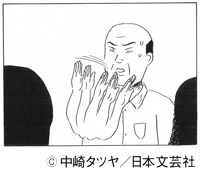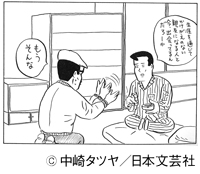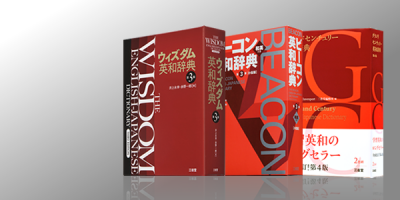The expression “iya iya” (No, no!) said with a falling intonation, whether used in the phrase “Iya iya, soo ja nain desu” (No, no! That’s not it.) or “Iya iya, mattaku mairimashita yo” (Oh no! I’m completely stumped.), is an “adult” technique. For example, while a “young lady” might say “uun” (uh-uh), she wouldn’t say “iya iya” with a falling intonation. She might affect a spoiled tone and say “Iya iya, mukae ni kite kurenai to naichau” (Oh no! If you don’t come and pick me up, I’ll cry.), but she wouldn’t say the “iya iya” with a falling intonation. She would say “iya” twice, each time with a rising intonation. That is, she would drastically lower the initial “I” sound, and raise the “ya,” then make the second “I” a little lower, and drastically raise the final “ya.” So, the single expression “iya iya” can be pronounced in various ways, each linked with the character of the speaker.
The same can be said for more physical techniques of refusal. In the Tatsuya Nakazaki(1) manga collection “Mondai Sarari-MAN,” Vol. 4 (Nihon Bungeisha, 1995), the refusal technique which we could provisionally call “the vertical one-handed wave(2)” appears in three places.

The first appearance is at the end of a comic illustrating the troubles of some tenants who live in the same apartment building (p. 54). A man is harangued, with increasing intensity, by a female tenant. “My underpants were stolen. You’re the thief! I don’t have proof, so I’m not going to tell the police. And I don’t want to be accused of slander, so I won’t tell anyone. But I believe you stole them!” Seeking help, the man flags down the building’s superintendent, who happens to be passing by, and pleads, “Please, say something to her!” The elderly, meek super, bald head glistening with sweat, a frantic expression on his face, violently fans his hand left and right in front of his body, using his entire forearm. His gesture says it all: “I–I’m not getting mixed up in this!”

The second appearance of this gesture also involves theft (p. 102). A good natured thief sneaks into a house, and finds a man sleeping there. The man is crying out so terribly in his sleep, that the thief feels compelled to wake him up. After hearing the thief’s explanation, the man hesitantly opens his mouth, and awkwardly blurts out “I think you may be my very best friend ever.” The thief, sitting politely on his knees and sweating profusely, immediately says “No. You’ve got it all wrong” while waving his forearm in front of his body.
This gesture appears for a third time in a scene where a man is apologizing for accidentally pressing a button that detonated a hydrogen bomb. The man, who is sweating and doing the vertical one-handed wave, offers his pitiful excuse “It’s not what you think! The button was dirty so I thought I’d clean it off.” (Sorry about the spoilers.)
In each example, an adult is sweating and doing the vertical one-handed wave, but this gesture is basically established as an “adult” technique even when done sans sweat. When asked to eat a despised food, say a carrot, a kindergartner will say “Iya!” (No!) with a rising intonation while shaking his head, but he won’t do the vertical one-handed wave. An “adult” however will, if she has another piece of food in her mouth, or is a little too far away to be heard without raising her voice; this is a restrained “adult” after all. The arm is usually waved from the elbow or wrist, but not often from the shoulder (although the late Rakugo(3) performer Katsura Shijaku(4) sometimes did this).
* * *








(1) 1955– Manga artist and winner of the 38th Bungeishunjuu Award.
(2) This gesture is performed by holding the hand up in front of the face or body and waving it left and right at the wrist or elbow. It can indicate a range of things from polite refusal to disagreement.
(3) A form of Japanese narrative comedy in which the performer tells amusing stories.
(4) 1939–1999 A Rakugo artist famous for performing in English as well as Japanese.